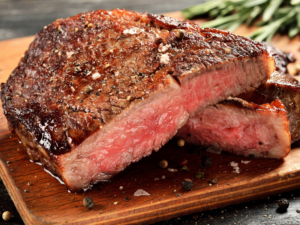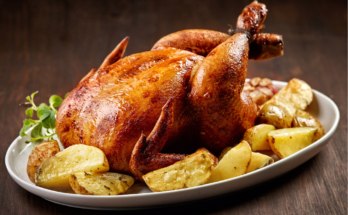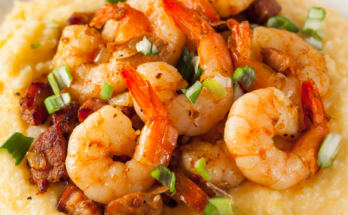There’s something undeniably satisfying about slicing into a perfectly cooked medium rare steak. That juicy, pink center, the slightly seared exterior, and the explosion of flavor with every bite—it’s no wonder this doneness level is a favorite among steak lovers. Whether you’re a home cook looking to impress or just craving a restaurant-quality meal, mastering the medium rare steak is easier than you might think. In this guide, we’ll walk you through everything you need to know: from selecting the right cut to cooking techniques, serving suggestions, and even a few pro tips to elevate your steak game.
What Makes Medium Rare Steak So Special?
Medium rare steak sits at the sweet spot between raw and well-done. Cooked to an internal temperature of 130–135°F (54–57°C), it retains a warm, pink center while developing a flavorful crust on the outside. This balance preserves the steak’s natural juices and tenderness, making it a go-to for cuts like ribeye, sirloin, or filet mignon. Unlike rarer preparations, medium rare offers a bit more texture on the exterior, while avoiding the toughness that comes with overcooking.
For many, it’s not just about taste—it’s about the experience. The vibrant pink hue, the melt-in-your-mouth feel, and the way it pairs with a glass of red wine or a tangy sauce make medium rare steak a timeless classic.
Choosing the Perfect Cut for Medium Rare
Not all steaks are created equal, and the cut you choose can make or break your medium rare masterpiece. Here are some top picks:
-
- Ribeye: Known for its rich marbling, ribeye delivers bold flavor and stays juicy at medium rare. The fat melts into the meat as it cooks, enhancing every bite.
-
- Filet Mignon: If you prefer a leaner, ultra-tender option, filet mignon is your match. Its subtle flavor shines at medium rare, especially with a sauce like béarnaise.
-
- New York Strip: This cut offers a great balance of tenderness and beefy taste, with just enough fat to keep it succulent.
-
- Sirloin: A budget-friendly yet flavorful choice, sirloin works beautifully when cooked to medium rare, retaining its texture without drying out.
When shopping, look for steaks that are at least 1-inch thick. Thinner cuts cook too quickly, making it tricky to hit that perfect medium rare sweet spot. Opt for bright red meat with good marbling (those little white flecks of fat) for the best results.
Prepping Your Steak: The Key to Success

Great steak doesn’t start with the pan—it starts with preparation. Follow these steps to set yourself up for medium rare perfection:
-
- Bring It to Room Temp: Take your steak out of the fridge 30–60 minutes before cooking. A cold steak cooks unevenly, leaving you with a gray ring instead of that uniform pink center.
-
- Season Generously: Salt and freshly ground black pepper are all you need for a classic medium rare steak. Sprinkle both sides liberally—don’t be shy! For an extra kick, add garlic powder or a sprinkle of rosemary.
-
- Pat It Dry: Use paper towels to remove excess moisture from the surface. This ensures a crispy, golden crust when you sear it.
Pro tip: If you’ve got time, salt the steak and let it sit uncovered in the fridge for a few hours (or overnight). This dry-brining technique draws out moisture and intensifies the flavor.
Cooking Methods for Medium Rare Steak
There’s more than one way to cook a medium rare steak, and the method you choose depends on your tools and preferences. Here are the most popular techniques:
Pan-Seared Medium Rare Steak
This is the classic stovetop method, perfect for a quick, flavorful result.
-
- What You’ll Need: A heavy skillet (cast iron is ideal), oil or butter, and a meat thermometer.
-
- Steps:
-
- Heat your skillet over high heat until it’s smoking hot.
-
- Add a high smoke-point oil (like avocado oil) or a mix of oil and butter for flavor.
-
- Place the steak in the pan and sear for 2–3 minutes per side to develop a crust.
-
- Check the internal temp—aim for 130–135°F for medium rare.
-
- Remove from heat and let it rest (more on that later).
-
- Steps:
Grilled Medium Rare Steak
For that smoky, outdoor vibe, the grill is unbeatable.
-
- What You’ll Need: A preheated grill (gas or charcoal), tongs, and a thermometer.
-
- Steps:
-
- Preheat your grill to high (about 450–500°F).
-
- Place the steak over direct heat and grill for 3–4 minutes per side.
-
- Move to indirect heat if needed and check for 130–135°F.
-
- Rest before slicing.
-
- Steps:
Reverse Sear for Precision
This slower method delivers edge-to-edge pink perfection.
-
- What You’ll Need: An oven, a wire rack, and a skillet.
-
- Steps:
-
- Preheat your oven to 250°F.
-
- Place the steak on a rack over a baking sheet and cook until it hits 115–120°F internally (about 20–30 minutes, depending on thickness).
-
- Heat a skillet on high, then sear each side for 1–2 minutes.
-
- No need to rest—the low oven temp keeps juices intact.
-
- Steps:
Why Resting Your Steak Matters
Once your steak hits that magic 130–135°F, resist the urge to cut into it right away. Resting it for 5–10 minutes lets the juices redistribute, ensuring every bite is as succulent as the last. Tent it loosely with foil to keep it warm while you prep your sides or sauce.
Pairing Your Medium Rare Steak
A medium rare steak is a star on its own, but the right accompaniments can take it to the next level. Here are some ideas:
-
- Sides: Creamy mashed potatoes, roasted asparagus, or a crisp arugula salad balance the richness of the meat.
-
- Sauces: Try a classic peppercorn sauce, chimichurri, or a simple garlic butter drizzle.
-
- Drinks: A bold red wine like Cabernet Sauvignon or Malbec complements the beefy flavors perfectly. For a non-alcoholic option, sparkling water with a twist of lemon cuts through the fat.
Common Mistakes to Avoid
Even seasoned cooks can stumble when aiming for medium rare. Watch out for these pitfalls:
-
- Overcooking: Use a meat thermometer to avoid guesswork. Every steak and stove is different, so timing alone isn’t foolproof.
-
- Skipping the Rest: Cutting too soon releases all those precious juices onto the plate instead of keeping them in the meat.
-
- Low Heat: A timid sear won’t give you that crave-worthy crust. Crank the heat and let it rip!
Tips from the Pros
Want to take your medium rare steak from good to unforgettable? Try these tricks:
-
- Baste It: After searing, add butter, garlic, and thyme to the pan, then spoon the melted goodness over the steak as it finishes.
-
- Double Check Doneness: Press the steak gently—medium rare feels like the base of your thumb when you touch your thumb to your middle finger. Pair this with a thermometer for accuracy.
-
- Experiment with Salt: Swap table salt for flaky sea salt post-cook for a satisfying crunch.
Why Medium Rare Is a Fan Favorite
Beyond the flavor and texture, medium rare steak has a reputation for being the “chef’s choice.” It’s safe to eat (assuming proper handling), showcases the quality of the meat, and offers a versatility that suits bold seasonings or minimalist prep alike. Whether you’re at a steakhouse or your own kitchen, it’s a doneness that delivers every time.
Final Thoughts on Medium Rare Steak
Cooking a medium rare steak is less about fancy equipment and more about technique, patience, and a little love for the process. With the right cut, a hot pan or grill, and a few minutes of your time, you can create a meal that rivals any upscale restaurant. So next time you’re in the mood for something indulgent, fire up the stove, season that steak, and savor the magic of medium rare. What’s your favorite way to enjoy it? Drop your tips or go-to recipes in the comments—I’d love to hear from fellow steak enthusiasts!



